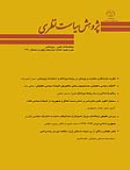بررسی تطبیقی دیدگاههای جریان اصولگرا و اصلاحطلب نسبت به مشارکت سیاسی زنان در جمهوری اسلامی ایران (1376-1384)
محورهای موضوعی : پژوهش سیاست نظریمحمد عابدی اردکانی 1 * , پروین عظیمی 2
1 - دانشگاه یزد
2 -
کلید واژه: اسلامگرایان فقاهتی (اصولگرایان) نواندیشان دینی (اصلاحطلبان) حقوق زنان و مشارکت سیاسی خانواده,
چکیده مقاله :
از پیروزی انقلاب اسلامی ایران تاکنون دو جریان فکری و سیاسی مهم و مؤثّر به منصه ظهور رسیدهاند. جریان اولی را که میتوان به لحاظ فکری آن را «جریان اسلامگرای فقاهتی» و از حیث سیاسی «جریان اصولگرا» نامید، بار اول در دهة شصت و بار دیگر در دهة هشتاد به اوج قدرت خود رسید وکماکان به آن ادامه میدهد. در مقابل، جریان دوم که میتوان از نظر فکری آن را «جریان نواندیش دینی» و از منظر سیاسی «جریان اصلاحطلب» خواند، در دهة هفتاد به اوج رشد خود رسید و از آن زمان، بهویژه پس از حوادث دهمین انتخابات ریاست جمهوری، به افولگراییده است. هدف اصلی این مقاله، بررسی تطبیقی دیدگاههای این دو جریان نسبت به مسئلة حقوق زنان، بهویژه مقولة مشارکت سیاسی آنهاست و فرضیة آن نیز عبارت است از اینکه: «مبانی فکری و دینی متفاوت این دو جریان، منجر به موضع ناهمگون آنها نسبت به مسئلة حقوق زنان، بهخصوص مقولة مشارکت سیاسی آنها، شده است». برای ارزیابی این فرضیه، سعی بر آن است تا با استفاده از روش توصیفی- تحلیلی، ضمن بررسی مبانی فکری و تلقی دینی دو جریان مذکور، مواضع آنها نسبت به مقوله حقوق زنان، بهویژه در زمینة مشارکت سیاسی و خانواده، مقایسه شود. یافتههای این پژوهش نشان میدهد که از یکسو بین مواضع دو جریان مذکور نسبت به حقوق زنان تفاوتهای قابل توجهی وجود دارد و از سوی دیگر، این اختلافات اساساً ناشی از تفسیر متفاوت، ولی غیرمنعطف، آنها نسبت به دین است.
Since the victory of Islamic Republic of Iran up to now, there emerged two significant and effective intellectual and political currents. The first current which could be called from intellectual dimension as “Juristic Islamism Current” and from political dimension as “Fundamentalism current”, got its climax political power in first and third decades of Islamic Revolution and it still keeps its power today. In contrast, the second current which could be called from intellectual dimension as “religious new thinkers” and from political aspect as the “Reformism current” reached its climax political power in the second decade of Revolution and from then on its is declining. The main purpose of this article is to comparatively review these two currents regarding the issue of women’s rights, particularly in relation to their political participation and its main hypothesis is as follows: “the different intellectual and religious principles of these two currents caused an inconsistency in their position toward the issue of women’s rights, particularly in relation to their political participations. To evaluate this hypothesis, using the descriptive-analytical method, it is tried to review intellectual and religious alphabets of these two currents and compare particularly these two in relation to political participation and family. The findings of this research shows that their attitudes toward the issue of women’s rights have significant differences in one hand, and in other hand, these differences are basically due to their different but inflexible interpretations of religion.

